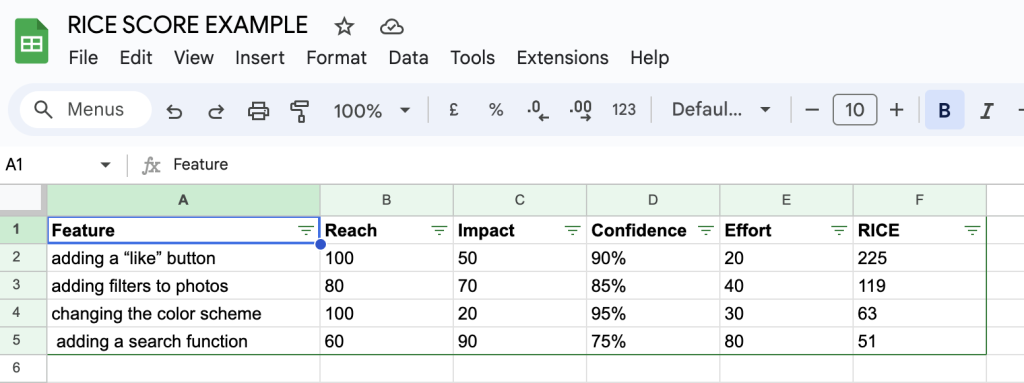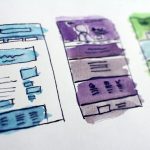When it comes to product management, one of the most important things you need to do is prioritize your features. This can be difficult, especially when you have a lot of ideas and not enough time or resources to implement them all. In this blog post, we will introduce you to the RICE Framework: a tool that can help you make tough decisions about what features to prioritize. We will also walk through a case study of how the RICE Framework was used to score features for a new software product.

What is the RICE framework?
The RICE framework is a tool that can be used to prioritize features or ideas. It was developed by the product management team at Intercom, and it stands for Reach, Impact, Confidence, and Effort.
Here’s how it works:
- First, you come up with a list of features or ideas that you want to score.
- For each item on the list, you give it a score from 0 to 100 for each of the four factors: reach (how many users will this impact?), impact (how big of an impact will this have?), confidence (how confident are we that we can deliver this?), and effort (how much effort will this require?).
- Once you have scored all of the items, you add up the scores for each factor to get a total score for each item.
- The items with the highest total scores are the ones that you should prioritize.
The RICE Framework
Reach
Reach is a measure of how many users will be impacted by a given feature. For example, if you are considering adding a new feature to your product that only a small number of users will use, it will have low reach. On the other hand, if you are considering a new feature that all of your users will use, it will have a high reach.
Impact
The impact is a measure of how big of an impact a given feature will have on your users. For example, if you are considering adding a new feature that will make your product slightly better, it will have a low impact. On the other hand, if you are considering a new feature that will make your product much better, it will have a high impact.
Confidence
Confidence is a measure of how confident you are that you can deliver a given feature. For example, if you are considering adding a new feature that is very complex and will require a lot of work to implement, you will have low confidence that you can actually deliver it. On the other hand, if you are considering a new feature that is simple and straightforward to implement, you will have high confidence that you can deliver it.
Estimated Effort
The effort is a measure of how much effort it will take to implement a given feature. For example, if you are considering adding a new feature that is very complex and will require a lot of work to implement, it will have high effort. On the other hand, if you are considering a new feature that is simple and straightforward to implement, it will have low effort.
Applying the RICE Framework
Case Study: Choosing between two projects
Let’s watch an example:
Imagine that you are the product manager for a new social media app. You’ve come up with a list of features that you want to add to the app, and you need to prioritize them.
Here’s how you would score each feature using the RICE framework: we have 4 different features to prioritize
- Feature A (for example: adding a “like” button):
- Reach: 100 (every user will be able to use this feature)
- Impact: 50 (this is a small change that won’t have a big impact on the app)
- Confidence: 90 (we’re confident that we can deliver this feature)
- Effort: 20 (this is a relatively simple feature to implement)
- Feature B (for example: adding filters to photos):
- Reach: 80 (some users will use this feature, but not all)
- Impact: 70 (this is a moderate change that will have some impact on the app)
- Confidence: 85 (we’re confident that we can deliver this feature)
- Effort: 40 (this is a more complex feature that will take some effort to implement)
- Feature C (for example: adding a search function):
- Reach: 60 (few users will use this feature)
- Impact: 90 (this is a significant change that will have a big impact on the app)
- Confidence: 75 (we’re somewhat confident that we can deliver this feature)
- Effort: 80 (this is a very complex feature that will require a lot of effort to implement)
- Feature D (for example: changing the color scheme):
- Reach: 100 (every user will be able to use this feature)
- Impact: 20 (this is a small change that won’t have a big impact on the app)
- Confidence: 95 (we’re very confident that we can deliver this feature)
- Effort: 30 (this is a relatively simple feature to implement)
RICE SCORE = (REACH * IMPACT * CONFIDENCE) / EFFORT
After scoring each feature and using the formula above we will get the real score for the list. In our case the best feature to implement is the A feature(adding a “like” button)
Fill free to copy our free template to make your own RICE scoring sheets
Conclusion
Of course, this is just one tool that you can use to prioritize features. There are many other ways to do it, and ultimately it’s up to you to decide what method works best for your team. But if you’re looking for a place to start, the RICE framework is a great option.









